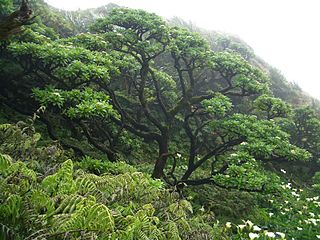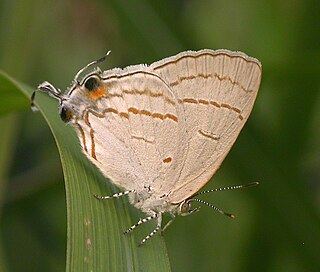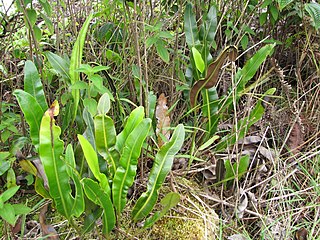
The Mascarene Islands or Mascarenes or Mascarenhas Archipelago is a group of islands in the Indian Ocean east of Madagascar consisting of the islands belonging to the Republic of Mauritius as well as the French department of Réunion. Their name derives from the Portuguese navigator Pedro Mascarenhas, who first visited them in April 1512. The islands share a common geologic origin in the volcanism of the Réunion hotspot beneath the Mascarene Plateau and form a distinct ecoregion with a unique flora and fauna.

The Dryopteridaceae are a family of leptosporangiate ferns in the order Polypodiales. They are known colloquially as the wood ferns. In the Pteridophyte Phylogeny Group classification of 2016 (PPG I), the family is placed in the suborder Polypodiineae. Alternatively, it may be treated as the subfamily Dryopteridoideae of a very broadly defined family Polypodiaceae sensu lato.

Cerro de Punta or just Cerro Punta is the highest peak in Puerto Rico, rising to 1,338 meters (4,390 ft) above sea level. The mountain is part of the Cordillera Central and is located in the municipality of Ponce.

The Slate Islands are a small archipelago in Lake Superior, Ontario, Canada, about 12 kilometres (7.5 mi) south of the town of Terrace Bay. The island group, consisting of 15 islands in total, was created by a meteorite impact which formed a crater about 32 km (20 mi) wide. In 1985, the Ontario government established the Slate Islands as a natural environment provincial park. The islands are notable for having Ontario's largest herd of boreal woodland caribou.

The Hawaiian tropical rainforests are a tropical moist broadleaf forest ecoregion in the Hawaiian Islands. They cover an area of 6,700 km2 (2,600 sq mi) in the windward lowlands and montane regions of the islands. Coastal mesic forests are found at elevations from sea level to 300 m (980 ft). Mixed mesic forests occur at elevations of 750 to 1,250 m, while wet forests are found from 1,250 to 1,700 m. Moist bogs and shrublands exist on montane plateaus and depressions. For the 28 million years of existence of the Hawaiian Islands, they have been isolated from the rest of the world by vast stretches of the Pacific Ocean, and this isolation has resulted in the evolution of an incredible diversity of endemic species, including fungi, mosses, snails, birds, and other wildlife. In the lush, moist forests high in the mountains, trees are draped with vines, orchids, ferns, and mosses. This ecoregion includes one of the world's wettest places, the slopes of Mount Waiʻaleʻale, which average 373 in (9,500 mm) of rainfall per year.

The flora of Saint Helena, an isolated island in the South Atlantic Ocean, is exceptional in its high level of endemism and the severe threats facing the survival of the flora. In phytogeography, it is in the phytochorion St. Helena and Ascension Region of the African Subkingdom, in the Paleotropical Kingdom.

Hypolycaena philippus, the purple-brown hairstreak or common hairstreak, is a butterfly of the family Lycaenidae. It is native to sub-Saharan Africa where it is commonly found in wooded locations.
Batrachedrodes is a genus of moths of the Momphidae family. All species of this genus are endemic to the Hawaiian Islands.
Elaphoglossum serpens is a rare species of fern that grows only on Cerro de Punta, the highest mountain in Puerto Rico. The fern grows at one location, where there are 22 known specimens. It was federally listed as an endangered species of the United States in 1993.
Mickelia is a genus of ferns in the family Dryopteridaceae, subfamily Elaphoglossoideae, in the Pteridophyte Phylogeny Group classification of 2016. It is one of the six genera of bolbitidoid ferns and is sister to the very large genus Elaphoglossum. It consists of about 10 species. All are native to the neotropics.

Elaphoglossoideae is a subfamily of the fern family Dryopteridaceae. It has previously been regarded as the family Elaphoglossaceae. As circumscribed by the Pteridophyte Phylogeny Group in their 2016 classification, the subfamily excludes the Polybotryoideae, which are kept separate. It can be divided into three clades: the bolbitidoid ferns, genus Pleocnemia, sister clade to the bolbititoids, and the lastreopsid ferns, sister to the combination of the first two clades.
Elaphoglossum pattersoniae is a very rare species of fern that is native to Peru and Bolivia. It is very close to E. guamannianum, but is smaller in size, its blade apex is acute-obtuse, it lacks dark arachnidoid scales on its abaxial costa and has fewer blade scales. It is named after Juliet Patterson, a New York Botanical Garden collaborator.

Lake Armor is a fjord lake located on the central plateau of the main island of the Kerguelen archipelago, in the French Southern and Antarctic Lands.

Elaphoglossum is a genus of ferns in the family Dryopteridaceae, subfamily Elaphoglossoideae, in the Pteridophyte Phylogeny Group classification of 2016.
Elaphoglossum nervosum, the veined tongue-fern, is a herbaceous plant, a member of the Dryopteridaceae family.
Elaphoglossum dimorphum, the toothed tongue-fern, is a herbaceous plant, a member of the Dryopteridaceae family.
Elaphoglossum hirtum is a species of fern in the Dryopteridaceae family. It is native to some islands in the Caribbean, the Azores and Madeira.









